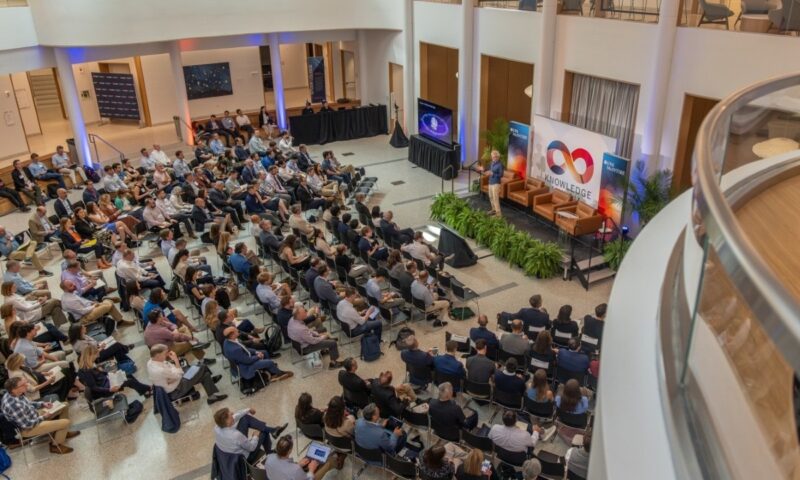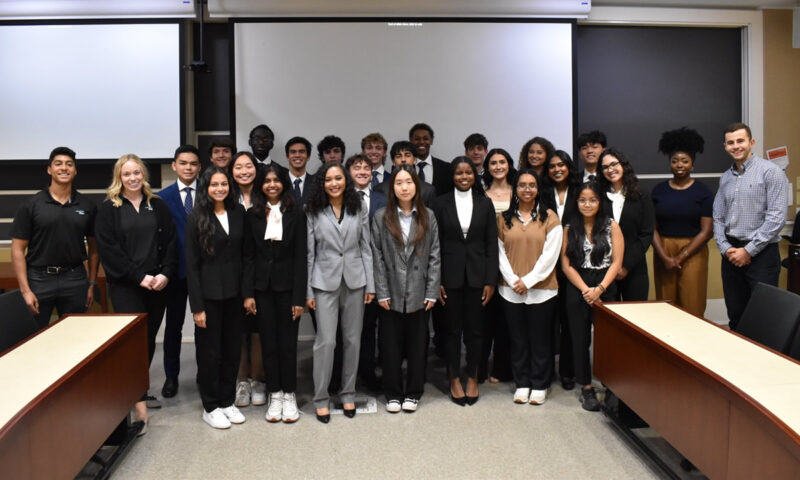Best-selling author of Hidden Figures: The American Dream and the Untold Story of the Black Women Mathematicians Who Helped Win the Space Race Margot Lee Shetterly and her inspiring work as a writer were the focus of an insightful conversation in UVA’s Old Cabell Hall Auditorium March 26, 2019. A Visiting Scholar to both the Schools of Commerce and Engineering, Shetterly spoke in a candid discussion with fellow alumna Heidi Connal (McIntire ’94), Managing Partner at Vast Sky Leadership, about how her Commerce School background has served her throughout an unpredictable career that led to success in fields beyond her early professional days on Wall Street.
Opening McIntire’s Centennial Speaker Series—keynotes and conversations in celebration of the McIntire School’s 100th anniversary in 2021—IT Professor Saonee Sarker welcomed the audience.
“At McIntire, we believe in engaged scholarship, an inclusive mindset, and the responsibility to use one’s own experience as a catalyst for change. And tonight, we are very pleased to welcome two esteemed McIntire alumnae who are change-makers in their own right,” Sarker said. “On a personal note, as a woman working in a STEM field and continuing to research on how today’s digital technologies can transfer differences in race, gender, and other forms of social inequities around the globe, I’m particularly honored to be presenting this evening’s event, because Margot’s work has been an incredible catalyst for visibility, understanding, and change on all of those fronts.”
A Show of Hands
As Shetterly’s New York Times best-selling title Hidden Figures and the subsequent film’s commercial and critical accomplishments (including a nomination for Best Picture at the 2017 Academy Awards) generated a great deal of audience interest, Connal took a moment to informally survey the crowd to discover who had read the book, seen the movie, or both. She also asked those in attendance how or if they were connected to the Commerce School and University, revealing that the McIntire and Charlottesville communities were well represented in Old Cabell Hall.
Shetterly then paused to introduce one of the central characters of her book, Dr. Christine Darden. Waving from the front row, the famous aeronautical engineer, mathematician, and data analyst known for her pioneering work in supersonic flight and sonic boom minimization received an enthusiastic round of applause.
A Change in Plans
Connal asked Shetterly to recount how she learned to find her own way through some of the decisions that took her from McIntire to her current work as a renowned nonfiction author.
Shetterly admitted that her career path was hardly a direct one, explaining how her initial plans to remain a lifelong fixture on Wall Street were revised multiple times.
“I thought that the first thing I did leaving the Commerce School would be the last thing that I did,” Shetterly said. “I had a job working on the foreign exchange trading desk at J.P. Morgan, and then went on to work in fixed-income capital markets at Merrill Lynch. But you know the end of the story: I’m sitting here talking about a book about mathematicians who worked at NASA 60 years ago—so I didn’t stay on Wall Street.”
Shetterly’s earliest finance jobs led to several stints consulting at New York-based internet startup companies, including one where she met her husband. The couple decided on a change of scenery and occupations, relocating to Mexico for 11 years, where in addition to other entrepreneurial ventures, they launched an English-language magazine catering to a sizeable retired American and Canadian ex-pat population. After that time abroad, the husband-and-wife team decided to see more of the world. The couple traveled 18 months before returning to the United States, and a little more than two years ago, chose to make Charlottesville their home.
Though Shetterly made some clear-cut decisions about a few of the major changes in her career, she said that she never made a conscious decision to become a writer. Rather, she was interested in pursuing a project about telling the stories of the African-American women at NASA’s Langley Research Center that history had overlooked.
Shetterly illustrated her revised employment trajectory using an analogy about landing on the moon. “You went around the back side,” she said. “Then you left your little spaceship parked in orbit and sent the lander down to the surface of the moon. That was the way that it happened. Sometimes brute force or the direct way is not the right way or the best way.”
Lifelong Lessons
“I really enjoyed my education at the Comm School,” Shetterly said, thinking back on the wide-ranging business education that has supported her entrepreneurial and creative endeavors. “My concentration was Finance, but there was a real spectrum of classes from ‘Commerce Law,’ ‘Accounting,’ ‘Management,’ and ‘Marketing.’”
Shetterly credited her McIntire courses with reinforcing essential skills such as writing well, communicating clearly, and collaborating with diverse teams: “Working with other people is certainly important if you’re starting a business, figuring out how to negotiate conflicts, and solving problems so that you can move toward a goal together—which we had to do working in groups at the Comm School.”
Both alumnae recalled the experience of analyzing data to make informed decisions and then crafting professional-level presentations without the convenience of a defined right or wrong answer.
Connal asked Shetterly if she would offer some advice for the students in the audience. While the author disclosed that she wished she had been less afraid of failure as a focused, ambitious undergrad, she acknowledged how difficult it is to envision coming up short in a positive way. She insisted, however, that many of the best lessons she had were the result of being forced to retool.
“Life is very competitive. I’ve got to get up. I’ve got this deadline and all of these things I want to do. But again, that is not always the best way to get to where you want to go. I really try to remind myself of that, which is still very difficult, as I’m still a bit of the fourth-year Comm School student,” Shetterly said, trading knowing smiles with Connal, who understood what the pressure to overcome any and all challenges can feel like.
Shetterly returned to the positive aspects of failure—an uncomfortable but effective method for prompting change and creating more opportunities.
“There’s so much to be said for what you do when plan A falls apart. Sometimes plan B or C or D is better,” she said. “What if it doesn’t work? What is your backup plan? What if you have to look at it a different way? What if being forced to look at it a different way is actually a better way? Sometimes you really have to run into your own walls. There’s no substitute for your own experience. People can tell you, but you have to go and learn it for yourself.”
Motivating Factors
Shetterly and Connal discussed how career choices often affect the identity of many Americans, and the increasingly competitive nature of our world. Connal proposed that switching fields in hopes of finding “the right mix of passion, purpose, and skills” can often motivate people.
Using the case of mathematician Dorothy Vaughan in Hidden Figures, Shetterly explained how hiring African-American women and offering them an improved income positively affected results for the American space program.
“It was a transformative economic event for their families,” Shetterly said. “Dorothy Vaughan was making $800 as a schoolteacher, and she earned almost three times that much by working at NASA. So there was certainly an economic motivation.”
When the NASA predecessor, the National Advisory Committee for Aeronautics, recruited at teachers’ colleges, Shetterly noted, NACA hired many women who were working as math teachers. “So this was an amazing revelation,” she said. “You could be a woman, gifted in math, and working as a professional mathematician. And all of a sudden, not only were you getting paid more, but you were doing very hands-on mathematical work with the most talented people in the world.”
Describing how the NASA mathematicians she wrote about performed crucial steps for manufacturing faster, safer aircraft capable of sending humans into space and to the moon, Shetterly revealed that until they began working for NASA, they believed they would spend their lives as teachers. Much like the author and former financier experienced in her own unpredictable career, the entry into the Space Race presented unexpected prospects: “All of a sudden this door opened and an entirely different life became available to them.”
An Honest Account
Finally, Connal asked Shetterly what being a writer is like.
Travel, networking, and the ability to work from her home office are advantages that make the job the most suited she’s had throughout her varied career, Shetterly said. Yet she seemed particularly taken with the act of research that took years to complete for Hidden Figures. Shetterly is also involved in capturing the stories of large numbers of women from underrepresented groups who made strides in transportation, communications, and military efforts in what she calls “The Human Computer Project,” which aims to detail their contributions to create an empirical dataset about their mobility. Research also currently occupies the bulk of her time as she develops the necessary historical foundation for her next book on African-American women entrepreneurs in mid-20th-century Baltimore.
“You start doing research for a book and looking into the past of these people who have led incredible lives, and you bring them back to life,” Shetterly said. “You immerse yourself in the details of their photos, their documents, their families, their work, their research, the time they lived in, the headlines of the newspapers on the day they were born—all of these things. It’s incredible. It’s like you’re getting into a time machine. I find it completely absorbing, and I find that all of those skills and experiences that I had along the way have benefited me in this particular job.”
Those experiences include Shetterly’s time at McIntire, which she insists have undoubtedly benefited her as a professional author. “I think it’s absolutely done so in a way that prepared me better than perhaps other writers,” she said. “I profoundly value the time I had at the Comm School. Being a writer is super-creative, but it’s a job, and it’s a business. If you are experienced in business and feel open to the idea that this is a very exciting startup, then I think that does give you an advantage. I feel that having started out as a business person, and ended up here, McIntire has served me very well.”



